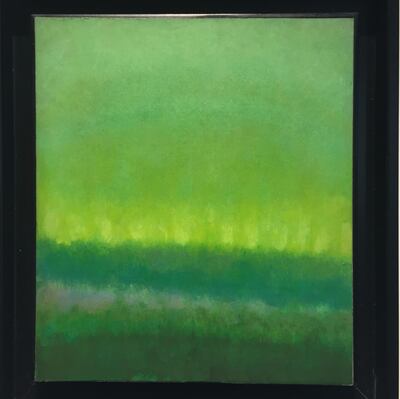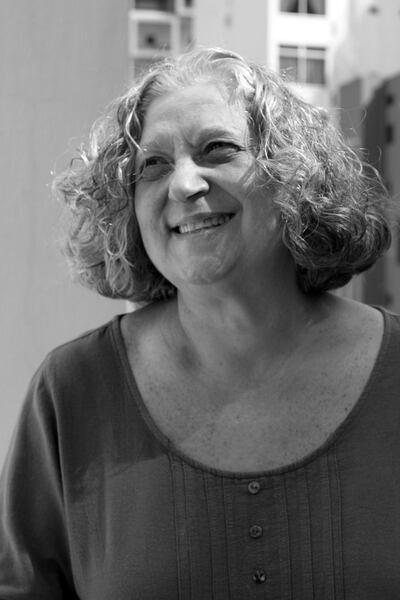My 11-year-old self was drawn to a halt the first time I saw Helen Khal’s work. The sheer colour and lucid transparency of these luminous paintings hanging in the home of our first-floor neighbours drew me in. I felt butterflies in my stomach. Their radiance felt illuminating and, in retrospect, I think I saw myself in them. That light that emanated from Helen’s paintings felt like it mirrored an emotional state, an inner light.
I was an impressionable child. Sensitive to a fault and terribly shy, my progressive parents believed I ought to channel, or rather release, my emotions in a creative manner. My mother noted my fondness for plasticine and paints, and promptly bought me an easel, which she placed in the laundry room on our building’s rooftop.
My new makeshift studio overlooked a dazzling vista of Ras Beirut, the "tip of Beirut" that boasted the red brick roofs of the American University of Beirut, tufts of pine trees and the azure Mediterranean Sea.
A cacophony of sounds rose from Makdisi Street below, a main artery of Hamra, Beirut's bustling district known for its fashion stores, cafes, bars, restaurants and hotels. Hamra was where the cultural intelligentsia gathered – Helen Khal and fellow artists Huguette Caland, Aref El Rayess and others included.
Those days of the 1960s were gold. Beirut was vibrant, alive, a tourist destination and a capital of the Arab world that celebrated visual and performing arts, literature, film, fashion, gastronomy and more.
The city was teeming with artistic potential; local, American, British and French cultural centres competed on what to show, leaving enthusiasts overwhelmed with choices. Helen was very much a part of that scene, largely because she was a first-rate painter who showed her work regularly (for the first time at Galerie Alecco Saab in Beirut in 1960 at the behest of her friend El Rayess), but also because she was a gallerist, an arts professor, author and critic.
Helen was born in Allentown, Pennsylvania, USA in 1923 and was of Lebanese descent. In 1946, she studied at the Lebanese Academy of Fine Arts, Alba and during this time, met and married Yusuf al-Khal, a Lebanese-Syrian poet, journalist and publisher. The couple moved to New York in 1948 where Yusuf worked for the United Nations as a journalist and Helen pursued studies at the Art Students League. They returned to Beirut in 1955.
In 1963, Helen established Gallery One, Beirut’s foremost gallery, and by this time, I’d learnt the basics of drawing and painting after my mother enrolled me at the Sami Salibi School of Fine Arts on Sadat Street in Ras Beirut.
Two years later, my parents called on Helen to give me painting classes. And so, my weekly "rooftop" art classes began. Always with a cigarette in her hand, Helen was mostly observant and sometimes to explain something, she would paint it instead of verbalising it. I learnt a lot about how to channel and focus my emotional experiences through colour treatment. The objective was to help me bring out what I wanted to say through art.
Helen was so witty and extremely open, but simultaneously reserved. I felt this discretion, a sort of distance; after all, ours was a relationship and process that was ultimately all about feelings and intuition, so how could I not sense her self-preservation?
I detected pain, and later learnt its source – her divorce and her husband forbidding her from seeing their two sons. She was a woman with so much passion for living and light, but who did not dwell in darkness though her life was dark. She had the presence of a mountain, a beautiful face etched with life and an energy that was so vivacious.
I graduated high school, and my sister suggested that I pursue architecture at AUB because I enjoyed geometry and art. The university was academically excellent, and even better socially.
This was the late 1960s, a glorious time for social and political change marked by student revolts, hippie culture, The Beatles, The Rolling Stones, nationalistic identities and the Palestinian issue.
And there were these giants, Helen, Huguette Caland, artist and professor John Carswell and others – figures whose dynamism was palpable. They were stars and I felt that I was light-years away from such a constellation.
Architecture wasn’t working out for me. I dropped it and compounded by my highly academic familial legacy, felt like a total failure. I chose fine arts, much to the delight of my family who felt that I had found my calling.
It was the best decision I made, and luckily, I took more classes with Helen, who taught at AUB from 1967-1976 (and at the Lebanese American University from 1997-1980) and also wrote for The Daily Star and Monday Morning. I felt that familiar connection in myself and with her again, and in her classes, she let us be, paying careful attention to each of us, always remaining in the background and guiding us on this journey of self-discovery.
I wanted to achieve the transparency in her painting, and asked Helen if we could freestyle. She agreed. I created a painting that came from the depths of my soul, built it from scratch, primed and stretched the canvas and then painted a veiled woman. Why would I paint a veiled woman in the 1960s? An art therapist asked me if the veil was not literal, but psychological, and a lightbulb went on.
I realised I used transparency to talk about inner life, to unveil, and my focus has since been about unveiling emotions. Helen included that painting (now with my niece) in a student show, which attracted the attention of several instructors who were curious about my development. I felt suddenly reborn, and I owe it to Helen, who allowed me to be, to discover myself.
My life has been an exercise in self-discovery and my paintings are a testament to that.
The thing is, it never stops. Helen taught me to chase butterflies in my stomach.
Remembering the Artist is our series that features artists from the region








